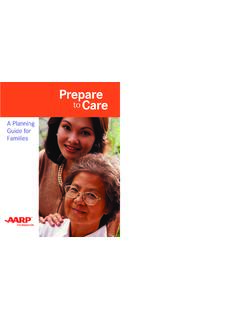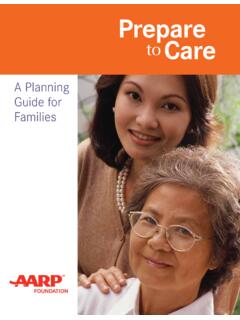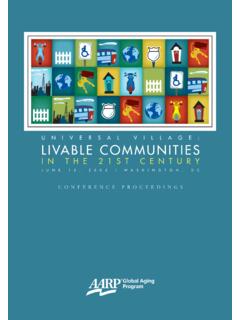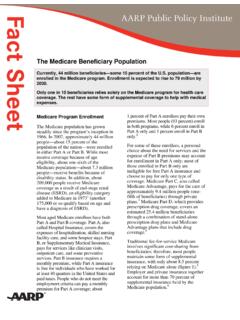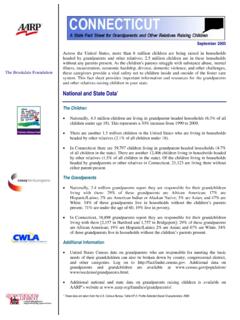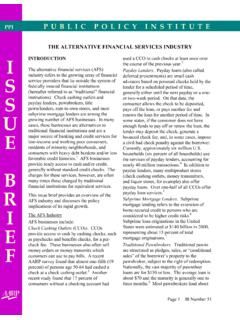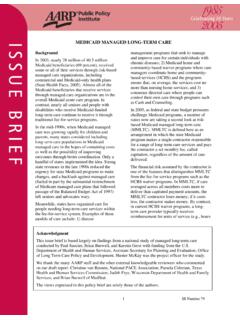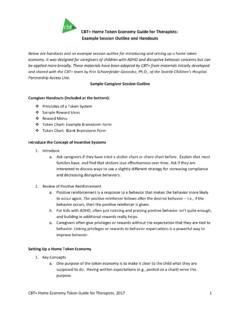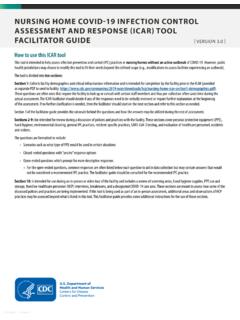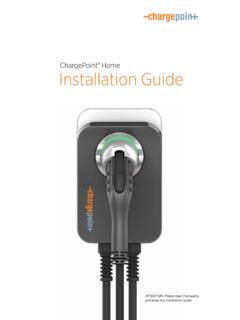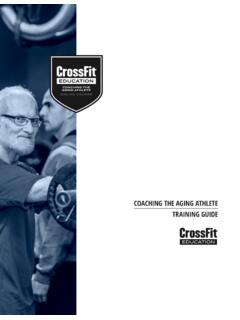Transcription of The AARP Home Fit Guide
1 The AARP home Fit Guide Information and Tips to KeepYour home in Top Form for Comfort, Safety, and LivabilityTHE AARP home FIT Guide {ii}ContentsHome Livability 1 Appropriate Housing 2 Assessing Your home for Livability 2 Universal Design 4 Universal Design Features 4 home Livability Evaluation Checklist 6 home Safety 7 home Safety and Falls 7 home Safety Checklist 7 Getting Started on Making Your home Safer and More Comfortable 13 Emergency home Exit Plan 14 home Maintenance 15 Your home Is Your Greatest Asset Take Care of It! 15 Seasonal Tasks Around the House 15 home Energy Conservation Tips 18 Free and Easy Ways to Cut Your Energy Bill 18 Energy Efficiency Projects That Save You Money 19 Getting Help 22 Certified Aging-in-Place Specialist (CAPS) 22 Finding an Occupational Therapist 22 Seven Steps to Hiring a Contractor 23 Resources 25 2008 AARP IntroductionWe love our homes. It doesn t matter if you own your home or rent, live in a small studio apartment or a grand man-sion, chances are your home means more to you than just the place where you live, keep your clothes, or receive your mail.
2 Our homes provide us shelter and much, much more. Whatever their size, they are our castles the site of cherished memories and life experiences, our place of refuge where we can be ourselves, relax, raise a family, or plant a garden. For older Americans, their home can provide a sense of com-fort, security, and independence. It figures prominently in their quality of life and it can also influence their physical independence and ability to participate in community activities. And, for the approxi-mately 80 percent of Americans age 50 and older who own their home , it can provide wealth which they can use for a variety of purposes such as serving as collateral for the upgrade and repair of the property, providing economic security for unforeseen expenses such as long-term care, or financing to future generations through inheritance. Eighty-nine percent of older Americans have told AARP they want to remain in their home and community for as long as possible.
3 AARP is com-mitted to helping them do that. Therefore, AARP is pleased to bring you a collection of home -related information and tips that can help you keep your home , in top form for comfort, safety and livability. We hope you find this information helpful. However, please know that the suggestions contained in this Guide vary from simple tasks to more complicated projects that may require professional help. If you are at all unsure of the level of skill needed or are uncomfortable about the amount of physical effort a project could take, then it is best to call in a professional. However, before you hire someone, follow our seven steps to hiring a contractor, located at the back of this booklet. INTRODUCTION{ }MELANIE ROBERTSHome LivabilityWhere do you want to spend your later years? Chances are you want to stay in your current home for as long as pos-sible. Is your home currently right for you and, if so, will it continue to match your needs and abilities as you age?
4 Think about HousingEveryone wants to live in a home that is appropriate and fits his or her needs and abilities. Unfortunately, most people don t discuss or think about the appropriateness of their home until a crisis occurs and it becomes obvious that they are living in a place that no longer meets their needs and houses and apartments are designed for young, able-bodied adults and do not accommodate the needs of older resi-dents or people with disabilities. Think of the steps in front of many houses. They are an inconvenience to a parent pushing a stroller, but to those with disabilities or someone who is older, they can be a barrier to living safely and independently. A well-designed home , or one that has been modified to accommodate the needs of residents of all ages and abilities, can promote inde-pendence and the satisfaction of staying in control and in your home as you age. Assessing Your home for LivabilityYour home is more than your physical surroundings.
5 It is the center of activities unique to your interests and routines. Occupational therapy practitioners are the professionals you can hire who can assess the fit between individuals and their environments so they can continue to participate in daily life activities that are important to them. Occupational therapy practitioners play a key role in identifying strategies that enable individ-uals to modify their homes to meet these needs. What Does an Occupational Therapy Assessment Entail?Once an occupational therapy practitioner is included in your home assessment, you can THE AARP home FIT Guide {2}expect to be asked about what you do each day and what your goals are for the future. Are you a gourmet chef? Or are you looking to simplify your cooking activities? Is your favorite feature of your home the yard and garden? Or is it the recreation room in the basement? Do you need office space to work on all those volunteer proj-ects you ve taken on since retirement?
6 Or, do wish you had a playroom for the grandchildren? Are you avoiding any activities that you used to do because they are difficult or you are worried about safety?Occupational therapy practitioners are also concerned about conditions you might have and how they impact your ability to participate in the activities you have discussed together. The interview may therefore include questions such as these:Does arthritis make certain activities painful or difficult? Have limitations in vision forced you to give up or curtail certain detail work? Are you experiencing balance issues or shortness of breath when climbing the stairs?You may be asked to perform specific tasks that can help determine the nature of the difficulty you are experiencing when engaged in them. How Does an Occupational Therapy Assessment Help Me?From the information gathered, the occupational therapy prac-titioner will make recommendations to adapt your environment so that you can safely, comfortably, and successfully do the things you want to do.
7 Possible occupational therapy recommendations might be:Adding grab bars, a handheld shower, and tub bench to increase safety in raised flowerbeds for better access when a standing combination lamp/magnifier to install by your easy chair for doing crossword puzzles or needlework. home LIVABILITY{ }BLAKE LITTLETHE AARP home FIT Guide { }Universal DesignAnother way to make a house appropriate for all residents is to incorporate universal design features into a home during the building stage or by modifying or changing an existing house. Universal design is about creating a home for everyone, regard-less of age, size, or ability. Universal design features and products make a home safer and more comfortable for a wide range of people. And, as the name implies, universal design fits everyone and every lifestyle including:Families with young adults who want to stay in their home as they grow who are taller or shorter than who have limited mobility or with a permanent or temporary Design FeaturesUniversal design features are those components of a home that work well for all residents, regardless of age or ability, and any guests who may visit.
8 They just make good sense. Having uni-versal design features and products in a home prevents acci-dents, increases comfort and safety, and enhances residents independence. Essential universal design features include:At least one no-step entry to the house either through the front, back, or garage doors that are at least 32 inches wide and interior doors at least 30 inches wide to allow for ample room to pass controls, electrical outlets, and thermostats that are easily reachable for a person in a three-foot wide corridor, free of haz-ards and steps that connects all rooms on the main door handles and faucets that don t require grasping or twisting to operate. bedroom, kitchen, enter-tainment area, and a full bathroom, with plenty of space for maneuverability, on the main bathroom walls for the option of adding grab addition to those listed, there are many other universal design features and products that many people, especially those over 50, like and incor-porate into their homes.
9 They include:Raised front-loading clothes washer, dryer, and dishwasher;Side-by-side refrigerator;Easy-access kitchen storage (pull-out shelves, adjustable height cupboards, lazy susans);Low or no-threshold stall shower with built-in bench or seat;Non-slip floors, bathtubs, and showers;Raised, comfort-level toilets;Multi-level kitchen countertops with open space underneath so one can work while seated;Windows that require minimal effort to open and close;Covered entryway or porch to protect you from rain and snow;Rocker-style light switches;Task lighting directed to a specific surface or area that provides illumination for specific tasks; andEasy-to-grasp cabinet knobs or pulls. { } home AARP home FIT Guide { } home Livability Evaluation ChecklistNow that you ve had the chance to think about your home , evaluate its livability, ask yourself the questions that follow and decide if your home meets your current and future livability requirements.
10 Your answers will let you know if you need to make changes or if you should search for a more suitable there at least one step-free entrance into the home ?Are there a bedroom, full bath, and kitchen facilities on one level, which are barrier free?Are the doorways and hallways wide enough to let a wheel-chair pass through?Do doorknobs and faucets have lever handles, which are easier to use than rounded knobs?Are kitchen countertops mounted at varying heights so they can be used while standing or seated?Can kitchen and bathroom cabinets and shelves be easily reached?Do the bathtub and/or shower have a non-slip surface?Are there grab bars in the bathroom or has the wall been reinforced so that you can add them?Are hallways and staircases well lit?Are there secure handrails on both sides of stairways?Can light switches, electrical outlets, and thermostats be easily reached even when seated?Can the windows be opened with minimum effort?If you would like a more complete assessment of your home for livability, enlist the help of an occupational therapist to aid you in identifying ways to improve safety in your home and ways you can modify your home to help compensate for any disability you may be SafetyHome Safety and FallsAmong people 65 years and older, falls are the leading cause of injury deaths and the most common cause of nonfatal injuries and hospital admissions for trauma.
